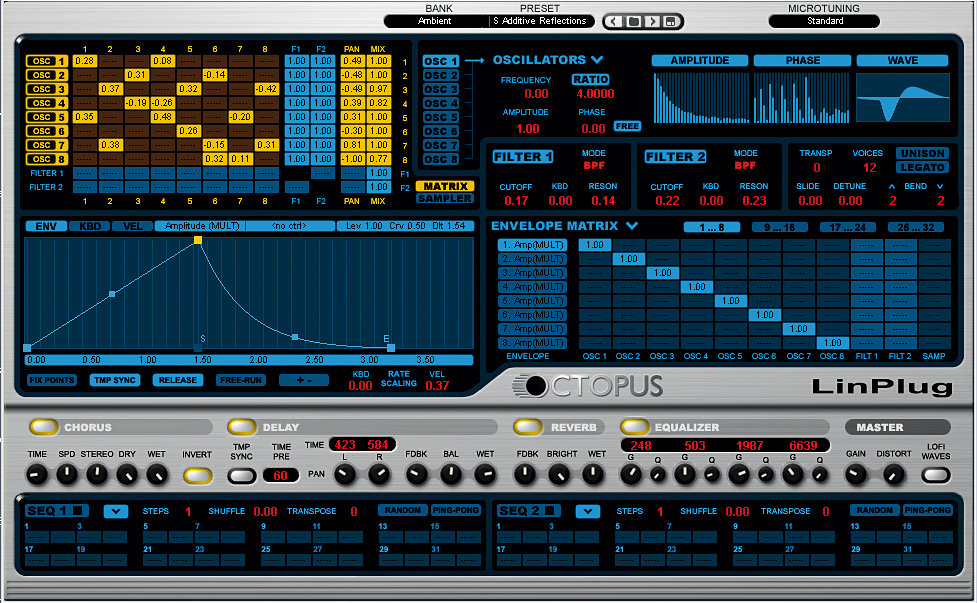MusicRadar Verdict
It may look intimidating, but Octopus is a fine-sounding, innovative synth that deserves to be explored.
Pros
- +
A fresh approach to FM. Sample import. Modulation mania! Some excellent presets.
Cons
- -
Beginners might be lost at sea. Sampler doesn't recognise embedded root note data.
MusicRadar's got your back

Octopus is a powerful and versatile synth-sampler.

It offers a vast range of sonic possibilities.
LinPlug has become something of an indie success story of late. The company started out by producing a succession of downloadable plug-ins, but its software has always been able to stand head-to-head with the better-known (and often much higher priced) boxed products that grace the shelves of your local music shop.
And this is precisely where the company's perseverance and dedication to quality has taken it - you can now find LinPlug's Albino and RMIV drum machine on those very same shelves around the world.
The fruit of the company's labours has now manifested itself in the aquatic-themed form of Octopus. You can put any thoughts of that tiny character sitting at the bottom of your fish tank aside - this particular Octopus is a many-tentacled monster of Harryhausen-esque proportions.
Overview
Octopus is a cross-platform hybrid synth-sampler plug-in that runs in both VST and AU hosts. At its heart is an eight-oscillator FM synthesizer that makes use of a modulation matrix that will be familiar to users of Maxx Claster's Toxic synth.
However, Octopus's oscillators depart from conventional FM oscillators in that they employ additive synthesis to produce timbres that are harmonically complex right at the operator level.
Each of the eight oscillators has 32 partials, and control over both phase and amplitude is on offer. Though we've seen customisable waveforms in more traditional subtractive instruments, they're not a common feature of FM synths.
Seasoned programmers will appreciate the sonic possibilities offered by this approach, while beginners - though they could initially find it slightly confusing - might actually learn a bit about the construction of sound by messing about with the various partials.
Although, technically speaking, FM synthesizers don't need filters, most modern software variations sport at least this one concession to subtractive synthesis technique.
Octopus is no exception - it comes with a pair of multimode resonant filters. They sound good, and do the job well enough.
What's more, their presence ensures that users who aren't so well versed in the arcane art of FM synthesis have something familiar to work with.
Filters are all well and good, but any FM synthesizer lives and dies on its modulation options. In this respect, Octopus excels. A good third of the instrument's display is devoted to its envelope generators, and there are no less than 32 envelopes to play with.
Thankfully, the limited old four-stage ADSR envelopes of yesteryear have been left behind in favour of multi-segmented, syncable envelopes of the sort that software synthesizer fans are accustomed to seeing in modern plugs-ins.
The envelopes can be edited using a graphical display, and it's possible to loop them and adjust the slopes of the segments.
Most importantly, these envelopes may be routed to any of a number of modulation destinations, thanks to a second mod matrix. Additional motion, should you require it, is provided by a pair of 32-step sequencers.
Octopus's output can be processed by the usual variety of effects, including delay, EQ, reverb, chorus and a touch of distortion.
User-friendly
You might be thinking that all of the above adds up to an indecipherable patchwork that's suited only to veteran sound designers.
However, while we'll concede that those users who have a deep understanding of FM synthesis will stand to coax the most out of Octopus, the developers have done a good job of keeping the instrument very user-friendly.
Wringing custom sounds out of Octopus is as easy as loading one of the many presets and adjusting a few partials, or tossing in a sample of your own.
If you can't be bothered, you can always call upon those factory patches - these have been created by some of the best designers in the business.
With everything from classic crystalline bells to bottomless echoing pads onboard, finding something you like shouldn't be too hard.
So, like its namesake, at first glance, Octopus can be a bit frightening. However, though it can initially seem to be rather alien and unsettling, the more you explore it, the more you start to appreciate its unique and versatile sound.
It's a welcome relief when a developer offers something different in a marketplace swamped with analogue emulations.
That said, Octopus isn't for everybody. If you're flummoxed by the smattering of knobs on a TB-303 or BassStation, you might be left scratching your head. However, if you enjoy creating new sounds, you might just get drawn in.
Computer Music magazine is the world’s best selling publication dedicated solely to making great music with your Mac or PC computer. Each issue it brings its lucky readers the best in cutting-edge tutorials, need-to-know, expert software reviews and even all the tools you actually need to make great music today, courtesy of our legendary CM Plugin Suite.

“We finally buried the hatchet!!!”: 20 years after he accused her of miming and called her “a fairground stripper”, Elton John and Madonna are speaking to each other again

“I didn’t think people would mind that I didn’t play it, but it became a problem. I got myself into a pickle”: Clairo says it was Charli XCX who convinced her to perform one of her most popular songs again

“It pretty much half killed us. Whether the band would continue was very much in the balance”: The Radiohead album that almost broke up the band, turned the music industry on its head - and became their best record










